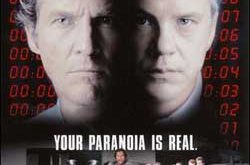 SYNOPSIS:
SYNOPSIS:
“Code 46 is a love story set in a Brave New World-type near-future where cities are heavily controlled and only accessible through checkpoints. People cannot travel unless they have papelles, a special travel permit issued by the totalitarian government, the ‘Sphinx’. Outside these cities, the desert has taken over and shanty towns are jammed with non-citizens, people without IDs forced to live primitive lives. William is a family man who works as a government investigator. When he is sent to Shanghai to solve a case of fake IDs, he meets a woman named Maria. Although he realizes she is behind the forgeries, he cannot help but fall completely in love with her. He hides her crime and they have a wild, passionate affair that can only last as long as his visa: 24 hours. Back home, William is obsessed with the memory of Maria. When the original investigation is inevitably re-opened a week later and William is sent back to finish the work he started, he tracks her down, only to discover she has been accused of a Code 46 violation and any further relationship is impossible.” (courtesy IMDB)
REVIEW:
A dystopia is defined as a society characterised by a focus on negatives such as mass poverty, public mistrust, martial law, squalor, suffering or oppression, that society has most often brought upon itself. Most writers of dystopian fiction explore at least one reason why things are that way, often as an analogy for similar issues in the real world. Dystopian stories are used to provide fresh perspectives on problematic social and political practices that might otherwise be taken for granted or considered natural and inevitable. Dystopias usually extrapolate elements of contemporary society and are read by many as political warnings. Many purported utopias reveal a dystopian character by suppressing justice, freedom and happiness.
 The most famous examples include Erewhon by Samuel Butler, We by Yevgeny Zamyatin, Brave New World by Aldous Huxley, Nineteen Eighty-Four by George Orwell, A Clockwork Orange by Anthony Burgess, and The Handmaid’s Tale by Margaret Atwood. More recently the genre has been embraced by young adult readers, found in such popular novels as The Hunger Games by Suzanne Collins, Divergent by Veronica Roth, The House Of The Scorpion by Nancy Farmer, Delirium by Lauren Oliver, and The Maze Runner by James Dashner. Filmmaker Michael Winterbottom‘s dystopian drama Code 46 (2003) is a provocative love story played out in the not-too-distant future between William Geld (Tim Robbins) and Maria Gonzales (Samantha Morton). In this future of genetic policing and tightly restricted travel, Geld is an insurance investigator on the hunt for forgers specialising in papelles, the identity cards that are now required for travel between cities.
The most famous examples include Erewhon by Samuel Butler, We by Yevgeny Zamyatin, Brave New World by Aldous Huxley, Nineteen Eighty-Four by George Orwell, A Clockwork Orange by Anthony Burgess, and The Handmaid’s Tale by Margaret Atwood. More recently the genre has been embraced by young adult readers, found in such popular novels as The Hunger Games by Suzanne Collins, Divergent by Veronica Roth, The House Of The Scorpion by Nancy Farmer, Delirium by Lauren Oliver, and The Maze Runner by James Dashner. Filmmaker Michael Winterbottom‘s dystopian drama Code 46 (2003) is a provocative love story played out in the not-too-distant future between William Geld (Tim Robbins) and Maria Gonzales (Samantha Morton). In this future of genetic policing and tightly restricted travel, Geld is an insurance investigator on the hunt for forgers specialising in papelles, the identity cards that are now required for travel between cities.
 Without a valid papelle, people are stuck living in squalor outside the cities and are deemed prisoners by the rest of society. During his search, Geld discovers that Maria, a woman from Shanghai, is one of the top document forgers. Because Geld has been infected with the ’empathy virus’ he cannot bring himself to turn Maria in to the authorities, and instead develops a romantic relationship with her that turns into a deep-seated love affair. Geld eventually realises that he is dabbling in dangerous territory. Besides betraying his job as well as his wife and child back in Seattle, he also neglects to think about how his one-night-stand with Maria has violated Code 46, a law designed to prevent genetically similar people from having children. Genetic engineering is a heavily regulated process where everyone’s DNA is tracked, and there are codes against reproducing with others, depending on their genetic formulas. In this way the movie is reminiscent of Gattaca (1997) in its portrayal of criminals defying a dystopian future that has rigid laws based on genetics.
Without a valid papelle, people are stuck living in squalor outside the cities and are deemed prisoners by the rest of society. During his search, Geld discovers that Maria, a woman from Shanghai, is one of the top document forgers. Because Geld has been infected with the ’empathy virus’ he cannot bring himself to turn Maria in to the authorities, and instead develops a romantic relationship with her that turns into a deep-seated love affair. Geld eventually realises that he is dabbling in dangerous territory. Besides betraying his job as well as his wife and child back in Seattle, he also neglects to think about how his one-night-stand with Maria has violated Code 46, a law designed to prevent genetically similar people from having children. Genetic engineering is a heavily regulated process where everyone’s DNA is tracked, and there are codes against reproducing with others, depending on their genetic formulas. In this way the movie is reminiscent of Gattaca (1997) in its portrayal of criminals defying a dystopian future that has rigid laws based on genetics.
 Winterbottom’s vision of the future is one in which people speak in a polyglot language combining English, Spanish and other languages. For example, when Geld travels to Shanghai he speaks in Spanglish: “Pray for me, un poco.” The characters use the Mandarin Chinese ‘Ni Hao’ for greeting each other, the Spanish ‘palabra’ for ‘password’ and ‘afuera’ for ‘outside’, the Basque word ‘agur’ for ‘hello’, and ‘Khoda Hafez’ being Farsi for ‘goodbye’. There are also words in Italian, French and Arabic. The idea is to portray a society that is not only multi-cultural but also with a language-fusion with expressions coming from the dominant languages of our present and those that are going to be dominant in our future. To further illustrate the multi-culturalism in this future world, in a scene inside a karaoke club, Mick Jones of The Clash performs Should I Stay Or Should I Go? soon after we see a young girl sing a traditional song from Portugal called Coimbra Menina e Moça.
Winterbottom’s vision of the future is one in which people speak in a polyglot language combining English, Spanish and other languages. For example, when Geld travels to Shanghai he speaks in Spanglish: “Pray for me, un poco.” The characters use the Mandarin Chinese ‘Ni Hao’ for greeting each other, the Spanish ‘palabra’ for ‘password’ and ‘afuera’ for ‘outside’, the Basque word ‘agur’ for ‘hello’, and ‘Khoda Hafez’ being Farsi for ‘goodbye’. There are also words in Italian, French and Arabic. The idea is to portray a society that is not only multi-cultural but also with a language-fusion with expressions coming from the dominant languages of our present and those that are going to be dominant in our future. To further illustrate the multi-culturalism in this future world, in a scene inside a karaoke club, Mick Jones of The Clash performs Should I Stay Or Should I Go? soon after we see a young girl sing a traditional song from Portugal called Coimbra Menina e Moça.
 There are plenty of high-tech gizmos such as credit-card-sized video mobile phones and touch-screen displays that control or access just about anything. Despite Winterbottom’s ability to portray a chilling future and to capture a wide array of urban territories including Dubai, Seattle, Shanghai and Hong Kong, the film’s slow pace can make it difficult for the average mainstream viewer. Code 46 captures a classic premise however, the enduring struggle for freedom. Despite its flaws, the film delves deeply into issues of empathy and morality in a highly controlled world. As fellow film critic Philip French said of Code 46, “It tries to run the gamut from Alphaville (1965) to Zardoz (1974).” Winterbottom’s stab at dystopian science fiction is as interesting as the rest of his genre-hopping catalogue, following In This World (2002) – a harrowing docudrama about Afghan refugees trying to get into the United Kingdom – and preceding the sexually explicit Nine Songs (2004). I’ll now vanish into the night, but not before inviting you to rendezvous with me at the same time next week when I discuss another dubious treasure for…Horror News! Toodles!
There are plenty of high-tech gizmos such as credit-card-sized video mobile phones and touch-screen displays that control or access just about anything. Despite Winterbottom’s ability to portray a chilling future and to capture a wide array of urban territories including Dubai, Seattle, Shanghai and Hong Kong, the film’s slow pace can make it difficult for the average mainstream viewer. Code 46 captures a classic premise however, the enduring struggle for freedom. Despite its flaws, the film delves deeply into issues of empathy and morality in a highly controlled world. As fellow film critic Philip French said of Code 46, “It tries to run the gamut from Alphaville (1965) to Zardoz (1974).” Winterbottom’s stab at dystopian science fiction is as interesting as the rest of his genre-hopping catalogue, following In This World (2002) – a harrowing docudrama about Afghan refugees trying to get into the United Kingdom – and preceding the sexually explicit Nine Songs (2004). I’ll now vanish into the night, but not before inviting you to rendezvous with me at the same time next week when I discuss another dubious treasure for…Horror News! Toodles!
 Horror News | HNN Official Site | Horror Movies,Trailers, Reviews
Horror News | HNN Official Site | Horror Movies,Trailers, Reviews






